“What’s black and blue and dead all over? You.”
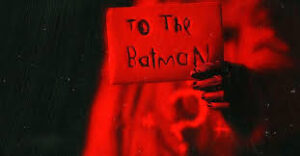
Screenplay by Matt Reeves & Peter Craig
“What’s black and blue and dead all over? You.”

Screenplay by Matt Reeves & Peter Craig
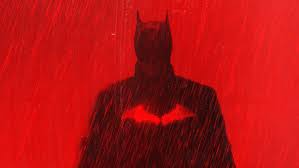
First off, The Batman was long. It was two hours and fifty minutes, and to be honest with you, it left me wanting more. I would have been happy if it came in at three hours, and I will explain why shortly. The old cliché that it didn’t feel like it was three hours long certainly applies here. For as long as it was, it was paced well with outstanding action sequences, a compelling story and characters that were rich and deep. It took a long time, but it finally feels like DC is finding its voice. They were trying to copy Marvel for a long time, but now they’re taking their films in a completely different direction and it is refreshing as hell.
The Batman is no mere superhero movie. It’s much more than that. It is a detective story. It is a crime drama. It is a mystery. It is a redemption story. It is nuvo noir. It is all of those together to create a cinematic experience that is more than just a Marvel carnival ride. This is a film that is the complete package. It has incredible action and a compelling story. Imagine such a thing!
Thankfully, director Matt Reeves and co-writer Peter Craig opted to forego the origin story route. We’ve seen that many times, and do not need to see it again. We meet Batman (Robert Pattinson) in this film as a veteran of the night and his vigilantism holds fear over some, but sadly turns into motivation for the Riddler (Paul Dano), who, as the hero of his own story, is terrifying Gotham by systematically killing the corrupt politicians that have been driving Gotham into the ground. With every new murder he commits, he leaves behind a clue for Batman, as though inviting him to find him.

This is where the film becomes a detective story. Batman works with Lt. James Gordon (Jeffrey Wright) to sift through the clues and try to solve the mystery of who is behind the murders. From this point, Reeves and Craig did a wonderful job of constructing a narrative that wasn’t built on car chases, but on characters having to solve a puzzle to chase the truth. The story is constructed in a way that everything is built on what came before it, and you actually have to pay attention to what’s going on in the story in order to get the most out of the experience.
That is one of the ways they made the narrative so strong over such a long timeline. Because the story was so compelling, it didn’t drag. It was never uninteresting. I was never looking at my watch wondering how much longer we had to go. The mystery that they were trying to solve held my attention and held my interest in what was admittedly a long film.
Then there were the action sequences, and they were great. Like all Batman movies since Tim Burton took over the franchise in the late 1980’s, this film is dark. Most of it happens at night or in dark spaces. Even daytime shots are gray and monotone. Other than the Adam West Batman series and film in the 1960’ where technicolor reigned supreme, Batman’s palette is limited and the lighting is almost always muted to dark. This often works against action sequences because it can make it difficult to see what’s going on. But Reeves and Director of Photography Greig Fraser played with light in just the right way to allow us to see and enjoy the stellar action sequences that they created.
The hand-to-hand combat scenes where well-choreographed and added to the intensity of the film. What’s more, there were quite a few of them, but they didn’t feel repetitive. And the lighting was subtle enough as not to draw attention to itself, but to allow us to see and enjoy the action.
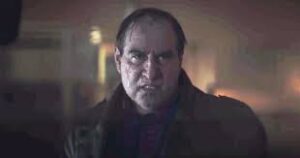
Then there was the car chase. At one point in the film, Batman is chasing the Penguin (Colin Ferrel in what should be an Oscar nomination Kat Ali for the stunning makeup job she did) that ends with the climax that many of us saw in the trailer. I would like to say that, in my humble opinion, The Batman might have the most badass Batmobile of any movie in the franchise. Just like most of the film, there is nothing flashy about this Batmobile. It is a solid muscle car through and through, and the scene in which Penguin thinks it’s blown up only to see it burst through the flames to run him off the road is one of my favorite shots from any movie in a long time. Ultimately for me, that’s what makes this film so enjoyable. It’s badass all around.
That leads me to the casting. I seem to recall a lot of backlash around Robert Pattinson being cast as the caped crusader when it happened. I will say this about his performance. I liked him a lot better as Batman than as Bruce Wayne. I didn’t dislike him as Bruce Wayne, but he brought a brooding and sullen aspect to the character that I think did him a bit of a disservice. The best Bruce Wayne’s to me are Michael Keaton and Christian Bale. They brought a debonair style to the billionaire that served as an archetypal mask for the pain and trauma he was feeling behind it. There was no such mask for Pattinson’s Wayne. His emotions were on his sleeve, and those emotions were mostly bordering on depression. It made Bruce Wayne come off as a flat character lacking depth, and that is the opposite of what Bruce Wyne should be.
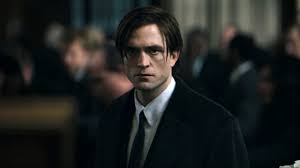
But as Batman, Pattinson absolutely brought it. He was simmering when he needed to be and explosive when he needed to be. It was the kind of portrayal in which, if you didn’t know any better, you might be unsure of which side of the law the Batman was on. He was constantly walking a razor’s edge and you never knew when he might cross the line. That type of performance helped establish and carry the intensity of the film and was one more element that kept it from feeling like it was as long as it was.
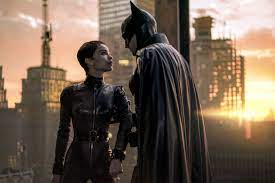
Zoe Kravitz was very solid as Selina Kyle, aka Catwoman, although I feel like they missed an opportunity with her. Catwoman is traditionally a villain in the Batman franchise, but there is always a not-so-subtle sexual tension between the two of them. There were a lot of film noir elements to this film and making Selina a traditional femme fatale would have been something that could have added a lot of depth to her character and added tension to the story. There needed to be more nuance to her character. We understand that she’ll do anything to avenge her friend, and she’s also still a cat burglar, but she should have been a character that could have tempted Batman to fully commit to being on the wrong side of the law. There was never any doubt that she was an ally to Batman in this film. She could have been more of a seductress who was attempting to seduce Batman to cross over to the other side. I liked what they went with her character development. She was certainly sympathetic, but she could have been a lot more.
The other characters were also very solid. Colin Ferrel, John Turturro, and Andy Serkis all gave solid performances in their limited screen time. Paul Dano as the Riddler was psychotic and scary and gave a performance of a character who was just over the edge far enough that there was no coming back. The scene between him and Batman in the jail is as intense of a dialogue scene as you will ever see.

Was this a perfect film? No, it was not. There were a couple of McGuffins that I would have liked to have seen get paid off. Early in the film, Alfred (Serkis) tells Bruce that the accountants are coming over because he could be on the verge of losing his fortune. We also find out that his father had started a Renew Gotham fund that criminals like Falcone (Turturro) had been pilfering from for years with no oversight. I think Reeves missed opportunities to tie both of those loose ends up at the end in a way that would have redeemed Bruce and his father from a flaw that had been tied to them over the course of the film.
Otherwise, though, this was a thoroughly entertaining film. If you haven’t seen it yet, do not let the long run time scare you away. This is a superhero movie that goes way beyond the superhero genre and gives us a thoughtful film that is thematically strong and has a compelling story to go along with all the action. It might not be a perfect film, but it sure is a terrific one.
“He doesn’t know it’s a damn show. He thinks it’s a damn fight. Now finish this bum, and let’s go home.”
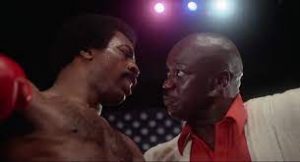
Screenplay by Sylvester Stallone
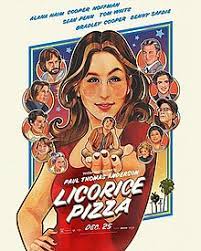
I have seen all of Paul Thomas Anderson’s films and it’s fair to say that he has a certain kind of voice through his filmmaking, and that voice is a dark one. There are exceptions, of course, but his films tend to be serious, deliberate, and artistic. Licorice Pizza goes against type more than any of his other films. It’s still artistic and, at times, deliberate, but it’s also a witty, charming, and (dare I say) spunky film about falling in love with someone despite the world telling you that you shouldn’t love that person.

The main character, Alana (Alana Haim), is one of my favorite characters from any PTA film. She’s an enigmatic free-spirit who has found herself as the target of the affections of a 15-year old boy, and she herself is 25. Like many of his other lead characters, she’s a lost soul who is trying to find herself in the world. However, what separates Alana from almost any other character in the PTA cannon is that she always manages to find the good in any situation. No matter what happens to her, she somehow ends up on the positive end of it. I would love to give examples, but you really need to see the film in order to know what I mean. The best example of it to watch for is when she’s asked to go out for a drink with City Councilman Joel Wachs.
PTA is a filmmaker for me who is generally hit or miss. I loved Punch Drunk Love, Boogie Nights, There Will Be Blood, and Phantom Thread. I really disliked Magnolia, The Master, and Inherent Vice. However, Licorice Pizza falls somewhere in between. I didn’t love it, but I didn’t hate it either. I found it to be one of his most entertaining films, but I had some real issues with the story. I also have a problem with the premise.
I will start with the premise first. It’s about a relationship that brews between Alana, who is 25, and Gary Valentine (Cooper Hoffman), who is 15. Alana, despite her internal issues, is pretty and cool and smart. Gary is a struggling child actor who is kind of dumpy and nerdy. Personally, it’s hard to believe that Alana would have anything to do with Gary, but she improbably shows up at the restaurant he invites her to and that’s when their relationship starts moving forward. As predatory relationships go, it’s probably not as predatory as the one in Call Me By Your Name, but at the very least, it’s problematic and not very realistic. I might have been able to buy it if she had been 22 or 23 and he had been 17, and probably better looking. Call me shallow, but I just didn’t see this relationship as realistic based on the parameters we were given. Honestly, if I’m being brutally honest, this premise feels more like a young boy’s fantasy playing out on the big screen than a realistic story scenario.

The point could be (and has been made) that this is a platonic relationship between a teenager striving to be an adult and an adult who’s afraid to grow up, at least until the third act. However, there are too many instances where the relationship becomes too flirtatious and there are too many other instances where one or the other of them is clearly jealous of the other being in a potentially romantic relationship for this to be viewed as platonic. These two people clearly have romantic feelings for each other almost from the start.
That leads me to the storyline, which had some great moments but ultimately ended up being less than the sum of its parts. The heading of this blog is that it was almost great. It was one of those frustrating storylines where the director puts his characters in potentially dramatic situations and plants ideas that can lead to serious consequences and then fails to pay them off. It was as though PTA fell into the trap of loving his characters so much that he didn’t want them to really get hurt, which is just about the most un-PTA thing ever. If you’ve seen any PTA films, one thing is for certain. Everyone is going to go through an emotional meat grinder. While there is a lot of emotional angst in Licorice Pizza, no one experiences the emotional pain that the characters do in The Phantom Thread or There Will Be Blood or Magnolia or even Boogie Nights or Inherent Vice.
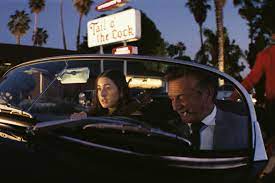
Plenty of bad things start to happen. Gary gets arrested on suspicion of murder but is quickly released. Alana is coerced into taking part in a dangerous stunt with a drunken Jack Holden (Sean Penn) but falls off the motorcycle as Holden takes off and is uninjured. It looks like they’re going to get caught running afoul of the psychotic John Peters (Bradley Cooper), but Alana miraculously coasts the moving truck they’ve rented, but is out of gas, in reverse down the hill.
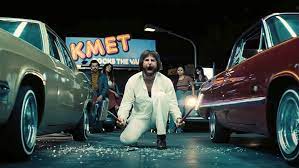
There is a moment at the end of that scene where Alana should have an epiphany. She’s hanging around with kids ten years younger than her. In fact, she does have a sort of epiphany, and she starts volunteering for a local city councilman who’s running for mayor of Los Angeles. We actually start to see some real character growth from her. At this point, I was hoping that we would see an ending like from The Way We Were or Casablanca where the two main characters understand that they can’t be together and each one goes on to live their separate lives. To me, an ending like that would have been a lot more satisfying.
Leading me to my final point. The ending is completely unsatisfying. It’s shot and cut together like it’s supposed to be this cathartic and emotionally powerful moment, but I felt nothing. I couldn’t care less. In fact, I saw what was coming, and I was rooting for something else. The opportunity was there for this film to have a strong and emotional ending, but like the rest of the film, that opportunity was missed.
As entertaining as Licorice Pizza was to watch, it is ultimately a movie that is plagued by missed opportunities. If PTA had cashed in on even a couple of those opportunities, this movie would have been a lot more dramatic and I would have cared a lot more about what happened. In the end, that’s what is so frustrating about this movie. All of the ingredients were there for this to be one of PTA’s best films. It was charming, witty, and funny, but ultimately there was no emotion and no depth and we’re left with no reason to care.
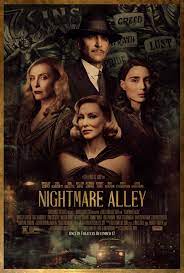
I was a little late to the party, but I’m glad I finally showed up while it was still going on. It’s a bummer that Nightmare Alley is doing so poorly at the box office because this is an excellent film that is cinematic enough that it ought to be seen in a theater in order to fully appreciate everything that’s going on.
Nightmare Alley is a movie fan’s movie. It has a lot of the motifs of classic Film-Noir, and if you have followed this blog in the past, you know that I have some definite thoughts on that style of filmmaking, and many of my favorite films are Noir. There are also elements of Nightmare Alley that reminded me a lot of Stanley Kubrick. Regular followers of this blog will also note that Kubrick is my favorite director and Guillermo del Toro channeled his inner-Kubrick when staging and pacing this film.
I’m going to get my critique out of the way. The only issue I had with the film was that some aspects of the storyline were a tad on the news and the twist at the end was predictable, but the predictability did nothing to reduce the tension in the overall story.
In fact, del Toro and co-screenwriter Kim Morgan did something strikingly similar to what Billy Wilder and Raymond Chandler did in what might be the greatest ever Film Noir, Double Indemnity. One of the first things to happen in that film is they give away the ending when Walter Neff in the recording he’s making for his boss Barton Keys, says, “I killed him for money, and for a woman. And I didn’t get the money, and I didn’t get the woman.” We’re less than five minutes into the movie, and they tell us essentially what the main character is going to want and that he’s not going to get it.
Del Toro and Morgan did a similar thing in Nightmare Alley, but this was around halfway through the film. The main character, Stanton Carlisle (Bradley Cooper) meets up with some old friends from his days at the circus, including the tarot card reader Zeena (Toni Collette), and she tells him not to try and pull the scam he’s working on. The tarot cards show that he’s not only going to fail, but it will be his downfall. We are basically told at the midpoint of the film that not only is Stanton not going to accomplish his goal, but the attempt will ruin him. Yet we are compelled to keep watching, mostly because del Toro and Morgan did an excellent job of getting Stanton tantalizingly close before the rug is pulled out from under him.
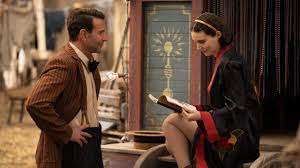
Another interesting thing about how this story was constructed was the actual dramatic structure. Normally screenplays are written in three (or four) act-structure with the direction of the story changing every 30 minutes or so. Like Stanley Kubrick did in Full Metal Jacket, del Toro gave us a 2-Act structure in which the hero, or anti-hero, in this case, goes through a sort of basic training in the first act, and then plies his trade in the second act.
We spend the first forty-five minutes of the story watching Stanton learn from Zeena and her husband Pete (David Stathairn), as well as circus boss Clem Hoatley (Willem Dafoe), the art of the con, and how to use the clues people unknowingly give you to tell them things about themselves that make them believe you’re psychic. When he’s able to use his technique to fool the local sheriff, he knows he’s ready to leave the circus for bigger and better things. He has been trying to convince circus performer Molly Cahill (Rooney Mara) of the same thing, and she’s finally convinced. Having fallen in love with each other, they climb in a truck and are off to the big city.
The second act begins with us having moved ahead in time two years. Stanton has grown a pencil-thin mustache. Gone are the worn-down clothes he wore at the circus, and they’ve been replaced by a debonair tuxedo. Molly has also changed. Her hair is stylish and her evening gown is elegant. They perform their show in front of a riveted audience, but there is a skeptic among them. Dr. Lilith Ritter (Cate Blanchett) is a local psychiatrist and she thinks she sees right through Stanton’s tricks. That is until Stanton goes the extra mile, and without help from Molly is able to deduce that Lilith carries a small handgun in her purse. Judge Kimball (Peter MacNeill) is so impressed that he’s willing to pay Stanton triple his current rate to put him in contact with his deceased son.
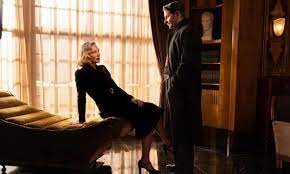
From there, the larger scam that will ultimately doom Stanton is put in motion. Molly tries to stop him multiple times, but Stanton falls into the trap laid for him by this film’s femme fatale in Lilith. Stanton is the stereotypical Film-Noir anti-hero. We learn right away that he is not a good man. Most of the first act is spent confirming how dishonest he is and the extremes that he’s willing to go to in order to get what he wants. He is constantly warned throughout the film not to take the scams too far, but he is a flawed character and those flaws of arrogance and hubris ultimately prove to be his undoing.

Even though this film doesn’t follow a traditional Hero’s Journey, there are still plenty of archetypal elements involved, particularly with the characters. The character development in Nightmare Alley is nothing short of superb. Pete serves as a Mentor to Stanton in the first act, and Lilith serves that role in act II, however, she also reveals herself to be a shapeshifter and a shadow by the end. There are several other tricksters and threshold guardians spread throughout the story.
The two-act structure also does interesting things to the pacing of the story. The pacing of this film is deliberate. Some may call it slow, and that could be why it’s struggling at the box office. This isn’t a Marvel movie with action sequences every ten minutes. This is a deliberate and methodical story that you have to pay attention to from start to finish. This story doesn’t follow the usual formula and it is largely character-driven. If you’re looking for an action movie, Nightmare Alley probably isn’t for you. But if you’re looking for a well-crafted film that’s filled with tension that slowly builds to a crescendo, this is a film you should check out.

Even though the story itself is somewhat on the nose and predictable, the character development makes up for that and helps keep the story interesting and tense. What’s even more amazing is how few of these characters are actually likable, and we can’t take our eyes off this film. These characters are taking us on a journey we know we shouldn’t be going on, but we can’t help but follow them down the dark path they traverse. This is an exceptional film that any cinephile should rush to see.

One of the consistent trends of the Eon Bond films is that the actors who have portrayed Bond often conclude their run with weak films. Whether it was Sean Connery ultimately bowing out of Bond with Diamonds Are Forever (no, I don’t count Never Say Never Again) or Roger Moore’s swan song with A View to a Kill or Pierce Brosnan closing his run with Die Another Day, the other actors have tended to go out with a whimper. Even though he was only in two films, I would even include Timothy Dalton in that group with Licence to Kill. So it was with great relief that Daniel Craig ended his run with a strong effort in No Time to Die. I would rank this film right in the middle of the Craig era. It’s a stronger film than Quantum of Solace or Spectre, but not quite up to the standard of Skyfall and Casino Royale, but it is closer to the latter two than to the former.
What holds this film back from reaching the level of Craig’s strongest Bond films is this film’s inconsistency. Director Cari Joji Fukunaga in his Bond directorial debut needs to be applauded for paying homage to the series, and especially the Daniel Craig era in the way that he did. There were several notable Easter Eggs scattered throughout the story, and one line of dialogue from a previous film was given particular importance in the story with great emotional impact. He also attempted to bring back some of the cheekiness from Bond films of the past to No Time to Die with some mixed results. The fight scene in Cuba was a good example of this. There was a lot of back-and-forth banter between Bond and CIA operative Paloma (Ana de Armas) that would have fit well in a Pierce Brosnan or Roger Moore action sequence but felt out of place with Daniel Craig.

And that sequence came after a much more typical opening where Bond is led to believe that the love of his life, Madeleine (Léa Seydoux) has betrayed him, forcing them to escape from a group of armed killers. Craig is at his absolute best in this sequence. He is intense and brooding and impulsive. These are the character traits that Daniel Craig brought to the character more effectively than any of his predecessors, and the film’s first 45 minutes were filled with that, but we kept getting injections of the cheekier Bond at various points throughout the rest of the film, and the results were mixed at best.

One quality that rarely shows up in Bond films is heavy emotion. Yes, there have been many dramatic moments throughout the history of the series, but you would be hard-pressed to find many moments that hit you hard with the feels, outside of the ending of On Her Majesty’s Secret Service. That is not in the least a criticism of the series. People don’t go to James Bond movies to be overwhelmed by emotion. They go to see these movies because they’re fun and funny and are loaded with action. It is the ultimate popcorn movie franchise. That is the lane that Eon Productions has chosen for these movies over the past sixty years, and they have carved out a clear path for themselves, while also blazing a trail for many other franchises to follow.
But No Time to Die broke that mold or at least fractured it. I’m not going to give any spoilers or go too in-depth to the story, but Fukunaga did as good of a job at exploring Bond’s psyche as any director in the series, and he, along with his co-screenwriters Neal Purvis and Robert Wade crafted a story and developed scenarios in which we are rooting for Bond the man rather than Bond the secret agent. Usually, the threat of a supervillain destroying the world is enough to get the audience to care, but Fukunaga, Purvis and Wade made this story personal for Bond.
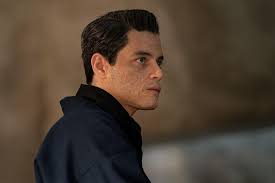
Another way in which Fukunaga harkened back to the earlier days of Bond was through the villain. The villains of the other Craig films were certainly menacing, but they were never the supervillains of Hugo Drax or Dr. No or earlier incarnations of Blofeld. They were all a part of the same culture and were looking for world domination of resources or certain markets, but there was something more personal as well. The villains of the Craig era despise Bond and have personal vendettas against him for either foiling their plans or being an obstacle for them. But none of them were looking to destroy the world in the same way that Lyutsifer Safin (Remi Malek) was in No Time to Die. Safin fits that archetype with his secret layer filled with minions and his diabolical plans to use a genetically coded biological weapon to wipe out entire populations. It is the kind of pure evil that was commonplace in earlier Bond eras and has been parodied in other franchises like Austin Powers and Despicable Me. Safin does have a personal grudge against Madeleine, but what makes him truly menacing is his desire to unleash this weapon on the world. Now, I wish Fukunga, Purvis and Wade had spent a little more time on Safin’s motivation for wanting to unleash this weapon. The surface was scratched on it, but something like that needed and deserved a little more in-depth.
So in a manner of speaking, Fukunaga, Purvis and Wade flipped the script on this story within the Craig-Bond universe. Rather than giving the villain a personal animus towards Bond and allowing the audience to root for a more global outcome, we are rooting for Bond on an entirely personal level while the villain is acting out globally. There is some crossover between them, of course, but this is the case in the general scheme of things.
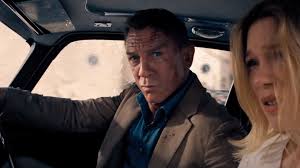
All in all, No Time to Die is perhaps the most dramatic Bond film ever. There is more to the story than whatever villainous plot Bond is trying to foil. There is a more personal story of Bond evolving as a man that is common in Craig’s Bond and was practically non-existent in previous Bonds. It’s a strong film that brings a satisfying end to Daniel Craig’s tenure with the role.
With that in mind, a thing or two should be said about that tenure. Going into this film, Craig was holding steady as the #2 Bond of all time behind Sean Connery. Did No Time to Die do enough to vault Craig ahead of the original and to most, still the gold standard? To that question, I can answer a solid “maybe”. I recently started reading all of Ian Flemming’s James Bond novels, and it is my opinion that Daniel Craig plays the character more similar to the books than any of his predecessors with the possible exception of Timothy Dalton. While Licence to Kill was a weak effort, The Living Daylights is a top-6 Bond film for me and Dalton’s brooding heavy performance was the perfect antidote coming off Roger Moore’s utterly forgettable A View to A Kill by which time the role had clearly passed him by. Dalton brought the simmering intensity and depth of personality that Bond had in the books but still held onto some of the lighthearted nature that Connery and Moore brought to the role. Plus, he only made the two films and didn’t have time to truly carve his own niche into the role. Daniel Craig, on the other hand, played the role straight for the first four of the five bond pictures he made. That’s why it was so jarring in No Time to Die when he went light-hearted in the moments that he did. But overall, Craig’s portrayal of the role was serious and flawed and with a touch of mystery. To me, Daniel Craig was the Bond with the most depth.
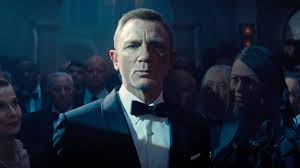
All that said, with this last film, I believe that Daniel Craig is running neck and neck with Sean Connery for the title of Best Bond. You could extoll the qualities of one over the other to me, and I would have a hard time arguing. I think at this point, and for the first time since George Lazenby replaced Connery, Daniel Craig has opened the possibility that you can now at least have a conversation over who was the best Bond.
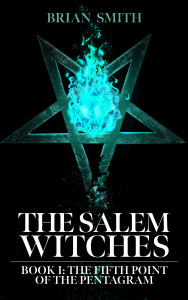
I admit it. I haven’t paid nearly enough attention to this site for far too long. The reasons for that are many and varied, but a concerted effort will be made to correct that. A part of that effort is the following announcement.
It is a Young Adult Fiction novel titled The Salem Witches Book I: The Fifth Point of the Pentagram, and it will be available for purchase on your Kindle or paperback on Amazon starting this weekend. I will also set up a store on monumentscripts.com and paperback copies can be purchased directly.
It is about a teenage girl named Abby who has been groomed by her mother since birth to be a witch. She discovers a secret a few days before her 18th birthday that leads her to question everything she’s ever been taught, and she decides that she no longer wants anything to do with witchcraft. Her mother, however, has big plans and she needs Abby to perform a deadly ritual to see those plans to fruition.
This novel has been in the works for a long time, and it took a rather circuitous route to get where it is today. I first got the idea when I took a Young Adult Fiction writing class a few years ago. It was a 6-week class and I had Chapter 1 written at the end of it. But then I was stuck. I had never written a novel before and I had no idea how to proceed, so I went back to what I know and wrote it as a screenplay. My thought process was that the screenplay could ultimately serve as an outline for a future novel.
I spent a long time reworking the story working with writers’ groups and screenplay classes and coverage services and friends who read it and gave me notes. I’m sure many of you are familiar with this process. I would work on it for several weeks, then shelve it for a while before going back to it again. I always had the idea in the back of my mind that I would someday turn it into a novel, but life has a funny habit of getting in the way and interruptions became more frequent. I became more focused on trying to get the screenplay sold or optioned as more time passed. When that didn’t work, my thoughts turned back to the novel. YA has served as source material for a lot of films over the years. The thought occurred to me that getting traction on a book and building an audience through the novel might be the key to finally getting past the Hollywood gatekeepers.
Like many people, I found myself with more free time than I had had in years with the onset of the pandemic. I was finally able to buckle down and go back to my original idea of using the screenplay as an outline for the novel. Now the novel is complete, and I’m ready to send it out into the world.

In what should have been a surprise to no one, and could largely be viewed as a coronation, Nomadland walked away with the night’s top honor, along with Oscars for Best Director (Chloé Zhau) and Best Actress in a Leading Role (Frances McDormand). Nomadland is a powerful film about self-discovery, overcoming grief and finding the courage to live outside of what society might consider to be the “norm” so you can find the peace to move on with your life.
For all of that, NomadLand should be lauded. Emotion and character drive this film more than plot. “See you down the road” is not only one of the most important lines of dialogue in the film, it’s also one of the driving thematic principles. Speaking of dialogue, there isn’t a ton of it in the film, and much of the dialogue felt improvised on the spot. It was shot like a docu-drama. If you didn’t know any better, you might have thought you were watching a compelling documentary about people living off the grid.
Also, this film was beautiful. I’m mildly surprised that it didn’t win for Best Cinematography as well, because the cinematography might have been the strongest component of the film. Not only did Zhau and Director of Photography Joshua James Richards capture the spectacular scope and vistas of the American west, they expertly used light and shadow to convey the mood and the state of mind of the characters. Richards also was keenly aware of when to show the depth of the space the characters were in when that was necessary, and when to flatten that space out to show just how small the space they were occupying could be.

I’m not going to get into a full plot summary for this film, because, as I mentioned, plot isn’t what drives this film. Watching Nomadland is like looking at a painting in a museum. To just glance at it, or to look superficially at its surface is to miss the overall point. Often times a painting isn’t just the capturing of a moment in time. There is a story within that painting and the painting needs to be closely examined over a period of time for the story to be made clear. Effort is required on the part of the viewer to discern the painting’s story and/or meaning. The pacing of Nomadland is slow and deliberate. At first glance, it feels like not a lot is going on, but that’s not entirely true.
WARNING: SPOILERS AHEAD!
The film starts out with some chiron about the death of the city of Empire, Nevada in 2011 due to the closing of a plant that was the city’s main employer for 88 years. We then see Fern (McDormand) cleaning out some personal items from a storage unit. She’s emotionally connected to some old men’s clothes and she carefully takes care of some old dishes before putting them in her van. We discover that she’s living out of that van, parking it in a camping site and working at the local Amazon packing plant for the holidays. But once the holiday season is over, she can no longer stay at the camp site and she needs to move on.
Through a friend she finds out about Bob Wells’ cheap RV living and that a group of people will be gathering in a sort of commune down in Arizona. She makes her way down there and learns the ways of the nomad. But she has found her tribe, if you will, including a kindly and helpful older gentleman named Dave (David Strathairn). She learns basic tricks for survival on the road, but she is still struggling to let go of the past, as evidenced by her angry reaction when Dave accidentlally breaks her dishes.
Over the course of the next hour and a half, Fern slowly learns to see the world around her in a way that she hadn’t before. From smaller details, like having a bucket to defecate in to more important things like making sure that her van has a spare tire, Fern starts to master the ways of the nomad. She’s even making human connections, whether it’s with Dave or her friend Swankie who’s slowly dying of cancer, but still has enough light in her eyes to clearly see the beauty in the world that surrounds us.
Fern does run into trouble when her van breaks down and it’s going to cost $2300 to fix. She doesn’t have the money and needs to borrow it from her sister, Dolly. She has to travel to Dolly’s home and spend some time there in order to get the money. There is a little bit of tension between Fern and Dolly and her husband George, especially when Dolly offers to let Fern stay with them, but Fern tells her she can’t stay there. Dolly hands Fern the cash and admits that she’s not as interesting as what’s “out there”. Dolly tells Fern that she admires her because she was always braver and more honest than everybody else. There is finally a moment of understanding between the two of them.

With her van back in commission, she then meets up with Dave again. Dave has left the nomad life behind and moved in with his son, who is starting a family of his own. Dave feels guilty because he was never there for his son and he felt like he wasn’t a good father. Fern advised him to be a good grandfather and he’s taking that advice. He asked Fern to come with him, and she finally takes him up on it to meet him there. She stays for a few days. The family likes her and there is a clear bond between Fern and Dave. But the call of the road is too strong, and she steals away one night without saying goodbye.
She meets back up with Bob Wells and his group. Swankie has passed away. She loved rocks so they all toss some rocks into a fire as an act of remembrance. As Bob throws his rock in the fire, he says, “See you down the road, Swankie.” Later on, Fern is talking to Bob and she tells him that after her husband died, she felt that if she left town, there would be no memory of him and it would be like he never existed. That’s why she stayed there even after the town was dead. She feels like now she spent too much of her time just remembering him. Bob then talks of his son who committed suicide a few years earlier. Bob has had a hard time with it, but realizes that he can honor his son by helping other people. He then talks to his about the philosophy of “see you down the road.” The lifestyle of a nomad is one of constant motion. You see people for a time and then move on. But somehow you always run into them again. It could be months, it could he years, but you always see them “down the road.” There is no final goodbye. That philosophy leads him to be certain that he’ll see his son again and she’ll see her husband again.
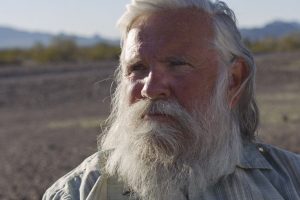
Fern then goes back to Empire. She empties out her storage unit and gives all her stuff away, saying she won’t miss one thing. She goes to her old house and looks at the view. She can finally move on.
We call carry baggage with us. That baggage can weigh us down and force us to revel in the past rather than living in the present and thinking about the future. Nomadland is telling us that there is a great big wide world out there. We need to break off the shackles of our past and step however we can into the future.
I’m inclined to say no. Yes, this was a powerful story thematically. It was told in a nontraditional way and the filmmakers took a risk in doing that. Nomadland is a movie that requires reflection. While I was watching it, I couldn’t wait for it to end. But after thinking about it, I have a much greater appreciation for it and a much deeper understanding of what they were trying to accomplish. I can also say that they did accomplish it. However, my favorite movie of the year was The Sound of Metal. I thought it was nearly as strong thematically and it was a more entertaining film to watch. If Nomadland was like eating your vegetables, The Sound of Metal was like adding a steak to it. I also preferred Judas and the Black Messiah, The Trial of the Chicago 7, Promising Young Woman, Minari, and The Father to Nomadland. There are various reasons for that. All of those films were more entertaining and most of them allowed a deeper emotional connection to the characters and what they were going through. I was not a huge fan of Mank, as I felt the story was too scattered. All that said, I understand why Nomadland won. It probably deserved to win. It just wasn’t my favorite movie of the year.
Yes, you should. If you are an aspiring screenwriter, or just a fan of good filmmaking, this is a movie that you should be familiar with. It tells a compelling story without a dynamic plot, without CGI effects and without crazy action sequences, or even any action at all. It’s an internal story with internal conflict, and it is a great film.
“Oh no, my dear, I’m a very good man. I’m just a very bad wizard.”
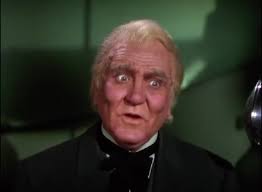
Screenplay by Noel Langley, Florence Ryerson and Edgar Allen Woolf
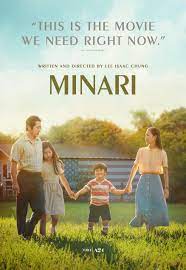
After watching Best Picture nominee Minari, I came away feeling like it was almost a great movie. It is a character-driven movie that relies on the challenges facing the various relationships to build drama. A couple of these relationships effectively hit the mark, but this is a movie that fell into the trap of writer/director Lee Isaak Chung putting characters into difficult situations and then easily and quickly extricating them from those situations. This severely hampered the amount of drama that he was able to build. In fact, almost from the moment the films started, we, as the audience, were being set up for a very dramatic story that was never manifested.
This is a story of a family of Korean immigrants who leave the stifling dead-end jobs of California in search of a better life farming their own land in Arkansas in the 1980’s. The family’s patriarch, Jacob (Steven Yeun) dreams of becoming a successful farmer growing Korean vegetables in the rich Arkansas soil. His wife, Monica (Yeri Han) is less than optimistic that this venture will work and is not happy with their new living conditions. Their young son David (Alan Kim) has a heart condition that prevents him from being able to run or exert himself in any way, and could kill him at any moment. Their daughter Anne (Noel Kate Cho) is at that awkward age of becoming a teenager and wants to be near friends.
They struggle at first with their new living arrangements, and have to work at a chicken sorting plant to make ends meat. But with no one to watch the kids, Monica’s mother, Soonja (Yuh-Jung Youn) moves in with them. She’s not your typical grandmother. She doesn’t cook and she likes to gamble at cards. She sleeps on the floor of David’s room, and their relationship is an awkward one at the start. However, David’s mischievous ways soon endear him to his grandmother, and their relationship grows in a heartwarming way. Soonja has a mischievous streak of her own and she leads the children into the woods one day, even though the kids aren’t allowed to be in there. There, she finds a creek that she declares is the perfect place to grow minari, which can be used as food, medicine and many other things.

I can’t say enough how impressive Chung was in building the relationship between David and Soonja. It starts off with both being antagonistic towards the other. But as they realize they have more in common with each other, their differences are slowly melted away and they form a bond that would have been unthinkable when Soonja was introduced. What’s more, Chung did this in an organic way that didn’t feel forced. There were moments of levity at every stage of the relationship’s development that brought humor to the story. That did two things. It made the characters likable and it allowed us to root for their relationship to grow and flourish.
On the flip side of that coin is the relationship between Jacob and Monica. They love each other as husband and wife, but the combined stress of being immigrants in the United States, having a son with potentially deadly heart condition, and the financial problems their experiencing are staining their relationship perhaps to a point beyond repair. Monica wants to move back to California. Even though they weren’t making much money, at least it was steady and they could live near a hospital. Jacob, however, is also feeling the strain of being an inadequate husband, father and provider for his family. He stubbornly wants to hold on to the farm and goes so far as to choose it over saving his family.

The dynamic between those two relationships should have been have been enough to craft a dramatic story around. Combine that with the fact that their an Asian immigrant family living in Arkansas in the 1980’s and this should be a very dramatic story filled with tension, potential heartbreak and ultimate redemption. Unfortunately, none of that happened because as good as Chung was at building relationships, he was lacking in following through on dramatic situations. It was as though he didn’t want to see his characters suffer too much. I have heard that this is an autobiographical story. That makes sense, because it’s easy to tell that he was too close to the characters. He would put them in potentially dramatic situations but diffuse any chance of any real conflict or drama happening almost as soon as they started.
That’s why this was almost a great movie. There were times where Chung took the story right to the edge of being very dramatic. He had given himself all of the ingredients for a dramatic situation. It would take just one more step to create that conflict and drama and then he pulled back before crossing the event horizon. He did this time and again throughout the film.
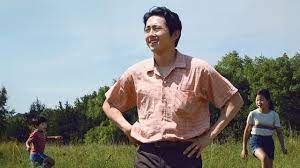
Looking at the racial component alone, there are several missed opportunities. This is an Asian family living in Arkansas in the 1980’s and if we’re being honest, they should have experienced significant racism, but they experienced practically none. The only time they get close to experiencing it is in a scene where they go to church and a little white boy asks David why his face is so flat. David says it isn’t and the boy shrugs it off and invites him to his house for a sleep over. Meanwhile Anne meets a little white girl who thinks she’s speaking an Asian language, but is only speaking gibberish. These microaggressions are borne out of ignorance and curiosity. There’s no malice there. Then in a later scene, David is having a sleep over at the boy’s house, and his father is there. The father is full-on redneck, and it’s totally reasonable to think that he’d get angry at the thought of an Asian boy sleeping in his house and eating his food. Nope. He’s totally cool to David and tells him to make sure he helps his daddy.
There’s another scene where Jacob is at a bank applying for a loan. The very nice white banker tells him he can have all he needs and not to be afraid to come back if he needs more.
What?!
Where is the drama? Where is the tension? It’s nonexistent.
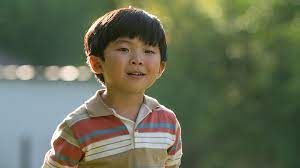
And I don’t know about you, but if it’s made clear at the beginning of a movie that a cute and likable little boy has a heart defect, then it’s reasonable to expect that something really bad is going to happen to that boy. Think Thomas J from My Girl. We learn early in that film that he’s allergic to bee stings. What happens later in the movie? He walks through a beehive and gets stung so much that he dies. I kept waiting for David’s heart condition to become a source of drama. There were some false starts where it looked like it would, but it was ultimately nothing more than a MacGuffin in a movie filled with MacGuffins.
This is important because the lifeblood of any dramatic story is the obstacle. As a writer or director, you need to put obstacles in front of your main characters that they must overcome in order for the story to move forward. Too many times in this movie are the characters confronted with obstacles that just kind of go away or end up not being obstacles at all.
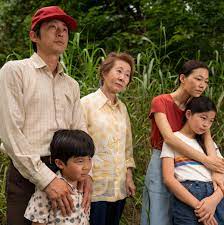
Minari is a feel-good movie that doesn’t follow through on its dramatic moments and situations. I find it a bit head scratching that it was nominated for Best Picture because it’s ultimately a frustrating movie that doesn’t fully deliver on its promise.